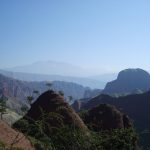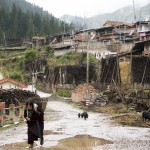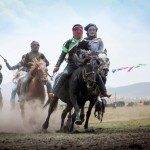Private Day Tour In Qinghai
Kunbula National Forest Park is an ideal place for traveling, sightseeing, vacation, camping and scientific expeditions. Kanbula is a spectacular area of weathered red sandstone, overlooking a reservoir on the headwaters of the Yellow River.
Qinghai Travel Guide introduces useful travel information of Qinghai including travel guide, tour itinerary, trip, travel tips, attractions, top things to do, tours, transportation, weather, climate, food, restaurants, accommodation, festivals, nightlife, activities, education, shopping, photos and maps.
Kanbula National Park
Located in Huangnan Tibetan Autonomous Prefecture, 131 kilometers (81.4 miles) from Qinghai’s capital city Xining, the Kanbula National Forest Park is an ideal place for traveling, sightseeing, vacation, camping and scientific expeditions.
Covering an area of 152 square kilometers (15,200 hectares), the park is famous for its unique landform of red gravel rocks, and features forest vegetation, lofty mountains, soaring peaks crystal water and Tibetan culture. With an altitude of 2,100 to 4,000 meters above sea level, it borders on the Yellow River in the north and is close to Lijiaxia Hydropower Station.
The weather amid the mountains can change very frequently.
Drive to Kanbula National Forest Park, in Tibetan its called Kamra. Located in west of Chentsa county in Huangnan Tibetan Autonomous Prefecture, 131km from the provincial capital city of Xining, covering an area of 152 sq km and the park is famous for its unique land formation, red rocks, forest, vegetation, soaring peaks, and Tibetan temples are the main feature of the park.Kanbula or Kamra national park is connected to the yellow river from the north and the yellow river also created one of the largest hydroelectric construction project on the Tibetan plateau. Approximately 60% of the Kanbula park is virgin forest, there are 276 species of plants and trees, including pine tree, cypress, and birch.The park is characterized by its spectacular mountain peaks, the center peak called Namdzong 2000m high from sea level, around of Namdzong, there are 18 identifiable peaks, among these, the highest group of six are revered as snow white abodes of gods. Gopodzong, Nepodzong, Bashingdzong, Trichdzong, Jomodzong, and Ngadzong.
Next we go to the Lijia Gorge, an important energy base in the upper reaches of the Yellow River in Qinghai, is also arranged for you.
Kanbula National Forest Park is located in the north-west of Jianzha County in Huangnan State, Qinghai. It is closely linked with the national key project Lijiaxia Hydropower Station.It is about 131 kilometers from Qinghai's provincial capital Xining.
Plant Landscape
This scenic area has abundant rainfall, cool and moist climate. Its forest coverage rate is about 28%; its plant resources are extremely rich. It has trees like Qinghai spruce, Chinese pine, white birch, Ulmus glaucescens, Prunus sibirica, etc...shrub plants like azalea, salix oritepha, Spiraea alpina, honeysuckle, etc...rare birds and beasts like blue sheep, argali, lark, blackbird, cuckoo and so on. Among them, the amount of flowers and plants which have high ornamental value is more than 80 kinds.
National Custom
Religious Landscape
Tips
Best Travel Time: Best from April to October. p.s. June and August will be the best months for a tour to Qinghai Lake.
Map coming soon...



















